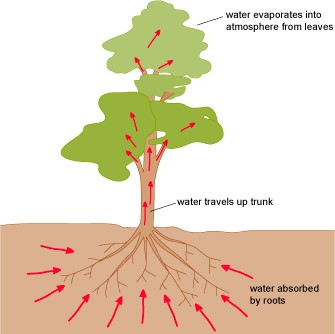Resource 2: Transport in plants
![]() Background information / subject knowledge for teacher
Background information / subject knowledge for teacher
Transport in plants
It is amazing!
Plants include trees such as the giant redwood trees of California, USA. These trees are often over 100 metres tall.
Even these tall trees can transport many litres of water up their trunks in just a few hours on a hot day.

What are the main substances transported by plants?
Water is transported from the roots through the plant and out through the leaves.
Mineral salts (ions) are transported from the roots to all parts of the plant.
Sugar, made in photosynthesis, is transported from the leaves to all parts of the plant.
Oxygen and carbon dioxide are transported through tiny holes (pores) on the surface of leaves and stems through a network of air spaces within the plant to and from all living cells.
What are the routes and mechanism of transport?
Water moves from the outer layer of the young roots to the centre of the roots, via cell walls and cytoplasm. It moves by diffusion and osmosis.
It then passes into the xylem cells. It passes up to the stem and leaves in the xylem in the transpiration stream.
Once in the stem and leaves water can pass out of the xylem to all the cells via the cell walls and cytoplasm, as in the root.
Mineral salts pass along the same route as water. They pass from cell to cell by diffusion or active transport. They pass up the xylem in the transpiration stream.
Sugar passes by diffusion from leaf cells to the phloem.
It passes from the leaves to the stem and root via the phloem. The mechanism for this is not fully understood.
Oxygen and carbon dioxide are transported through tiny holes (pores) on the surface of leaves and stems through a network of air spaces within the plant to and from all living cells.

The transpiration stream
Most of the water moving through the plant evaporates from the surfaces of the cells inside the leaves and escapes from the leaves as water vapour. The evaporation from the aerial parts of the plant is known as transpiration. The sun provides the heat energy for this evaporation to occur.
A continuous column of water extends from the outer surface of the cells inside the leaf through tiny spaces in the plant cell walls to the water inside the xylem vessels.
Because of its special cohesive properties (water molecules ‘want’ to stick together) water that has evaporated from the leaves is replaced by water drawn up through the xylem.
The water column at the bottom of the xylem in the roots is continuous with a water network in the walls and cytoplasm of the root cells all the way to the outer surface of the root.
Stomata
Stomata (singular, stoma) are found on the surfaces of leaves – also of stems and flowers. A stoma is a pore or hole. It is surrounded by two cells called guard cells. These guard cells can change shape and this alters the size of the pore, allowing the amount of water vapour, oxygen and carbon dioxide that can pass through the pore to be controlled.
Water uptake by the roots
Plant roots form a branching network in the soil. Uptake of water and mineral salts is mainly carried out by the ends of the youngest roots. Just behind the tips of the branches of the roots is a region of root hairs. These are formed as extensions of the cells in the outer layer of the root (root epidermal cells). These root hairs increase the surface area for absorption of water and minerals from the soil.
If the stem of a plant is cut at its base, water exudes from the cut stem. This suggests that a pushing force is generated in the roots – root pressure. Root pressure on its own is not enough to drive water to the top of the tallest trees.
Resource 1: Practical Work



